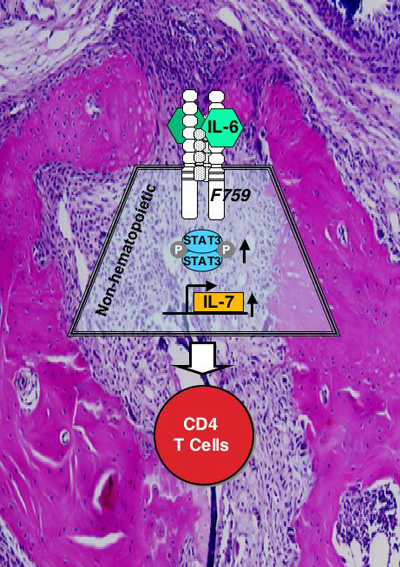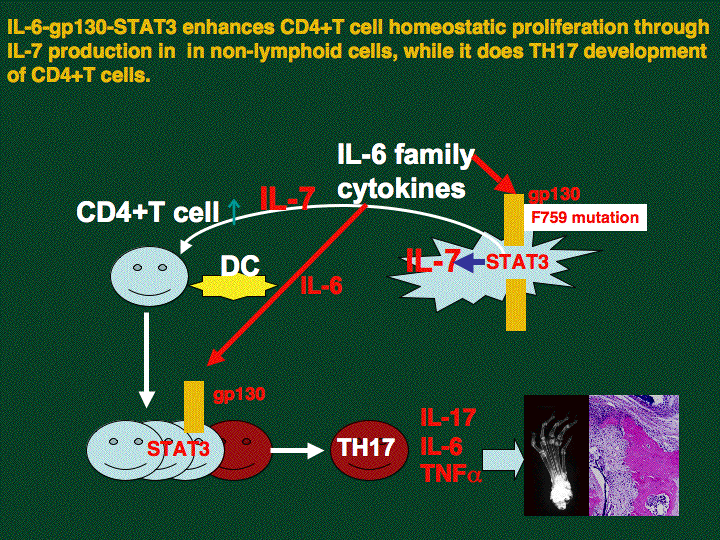ADDRESSJST-CREST 2-1, Yamada-oka Suita, Osaka 565-0871, Japan TEL:81-6-6879-4856 Masaaki Murakami, Ph.D., D.V.M. |
AchievementsIL-6-gp130-STAT3-IL-7 cascade in F759 mice causes autoimmune arthritisA new concept that the interaction of immune system and non-immune system causes autoimmune disease
Hyperresponsiveness to the interleukin (IL)-6 family of cytokines triggers a spontaneous rheumatoid arthritis (RA)-like disease in mice (Atsumi et al, JEM 2002)(PubMed). Now, Sawa and colleagues show that excessive IL-6 signaling drives hyperproliferation of CD4+ T cells, which then attack the joints. IL-6 has been implicated in RA and other T cell-driven autoimmune diseases. Indeed, a previous study by this group showed that an activating mutation in the gp130 subunit of the IL-6 receptor caused a lymphocyte-driven arthritis in mice. But the mechanism was unclear. The authors now show that disease development in these mice depends on CD4+ T cells, but not on cytolytic CD8+ T cells or antibody-producing B cells. The CD4+ cells did not appear to cause disease because of an affinity for joint-specific antigens. Rather, the cells simply proliferated excessively in the mutant mice. This hyperproliferation was not the fault of the T cell, as wild-type CD4+ T cells also multiplied excessively and caused disease when transferred into irradiated mutant mice. Rather, the gp130 mutation caused nonhematopoietic cells to produce excess IL-7--a growth factor that triggers T cell proliferation. This is the first evidence that IL-6 family cytokines can trigger IL-7 production. These data suggest that IL-6, which is elevated in the serum and joints of patients with RA, might exacerbate disease by inducing IL-7 and thus driving T cell activation. What causes the overstimulated T cells to attack the joints in the first place remains a mystery. J Exp. Med. In This Issue Autoimmunity: Cytokine partnership to destruction: Researchers reporting in The Journal of Experimental Medicine have identified the mechanism behind a form of spontaneous autoimmune arthritis that occurs in mice with a mutation in the interleukin-6 (IL-6) receptor subunit gp130. Intriguingly, it turns out that signalling by this mutant IL-6 receptor in non-haematopoietic cells ----, taken from Nature Reviews Immunology 6:493, 2006, July Issue, Research Highlights.
The role of IL-6-gp130-STAT3 cascade in autoimmune diseases was further shown by Nishihara et al who indicated IL-6-gp130-STAT3 signals in T cells directs TH17 development. *Nishihara, M., *H. Ogura, N. Ueda, M. Tsuruoka, C. Kitabayashi, F. Tuji, H. Aono, K. Ishihara, E. Huseby, U. A.K.Betz, M. Murakami and T. Hirano. (*equal contribution) IL-6-gp130-STAT3 in T cells directs the development of IL-17+T helper cells with a minimum effect on that of Treg in the steady state. Int. Immunol. published online May 9 (PubMed)
|
|
Copyright © 2007 Osaka University all rights reserved.
|
|
 Sawa, S., D. Kamimura, G.-H. Jin, H. Morikawa, H. Kamon, M. Nishihara, K. Ishihara, M. Murakami, and T. Hirano. Autoimmune arthritis associated with mutated IL-6 receptor gp130 is driven by STAT3/IL-7-dependent homeostatic proliferation of CD4+ T. J. Exp. Med. published on line 22 May 2006
Sawa, S., D. Kamimura, G.-H. Jin, H. Morikawa, H. Kamon, M. Nishihara, K. Ishihara, M. Murakami, and T. Hirano. Autoimmune arthritis associated with mutated IL-6 receptor gp130 is driven by STAT3/IL-7-dependent homeostatic proliferation of CD4+ T. J. Exp. Med. published on line 22 May 2006 